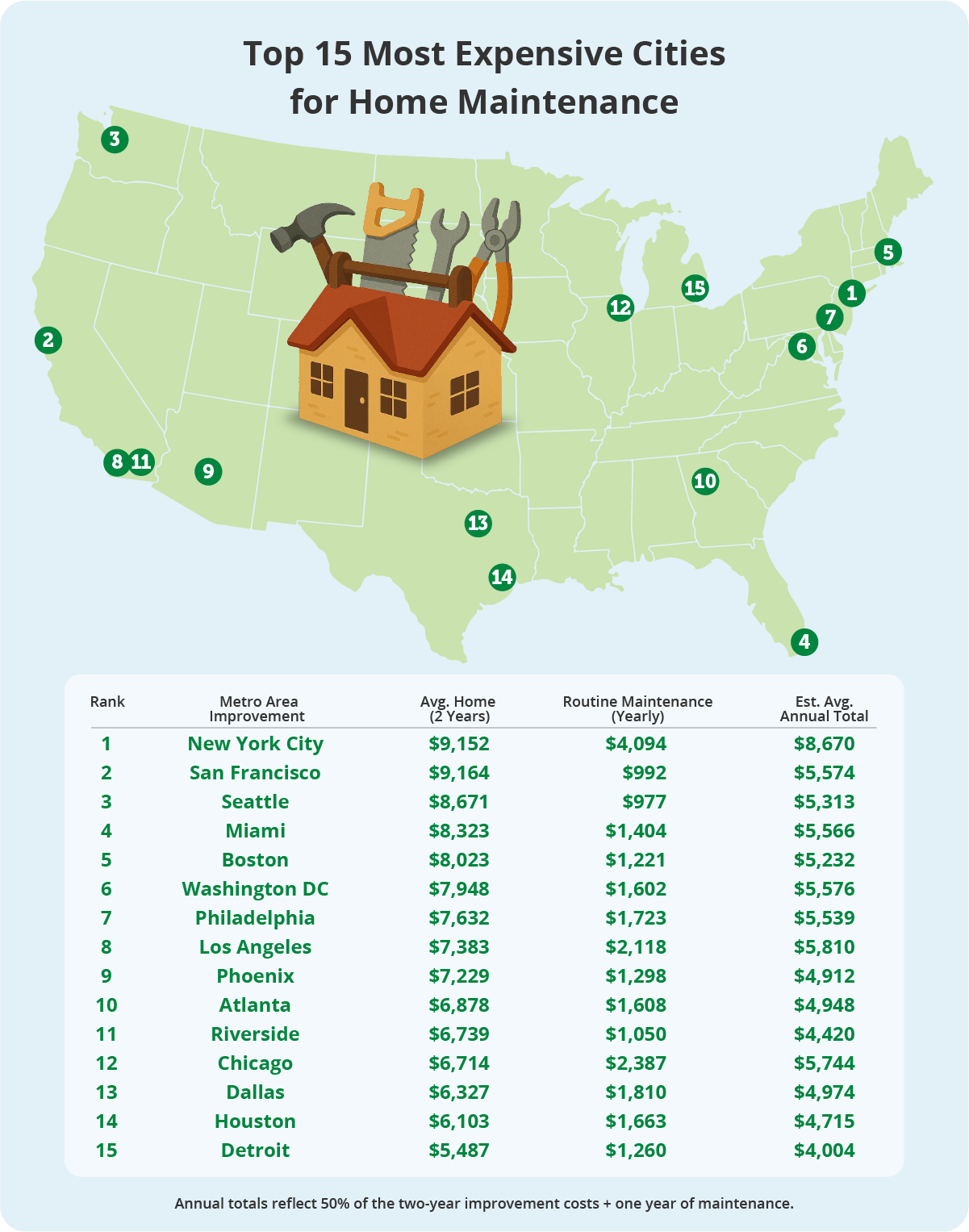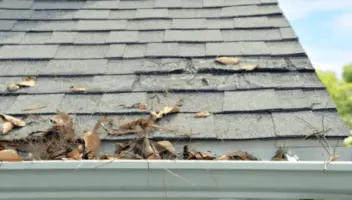America’s Most Expensive Cities for Home Maintenance

If you’re a homeowner, you know the to-do list never really ends, and neither do the costs. In some parts of the country, simply keeping your home in good shape can stretch the budget more than you’d expect. We analyzed two years of home improvement spending and one year of routine upkeep data from the US Census American Housing Survey (2023-2025) to find out which U.S. cities are the most expensive for home maintenance, and why it matters.
Whether you’re dealing with snow-damaged roofs, clogged gutters, or sun-worn siding, one thing is clear: catching issues early can save you thousands. The best way to lower those bills? Get ahead of the damage before it starts.
Key Takeaways
- New York City takes the top spot, with homeowners spending more than $8,600 a year just to keep things in working order.
- West Coast and Northeast metros dominate the list, thanks to older homes, extreme weather, and higher labor costs.
- Preventative care makes a difference: smart solutions like LeafFilter help reduce long-term costs by stopping damage before it starts.
The Top 15 Most Expensive Cities for Home Maintenance
Keeping a home in good shape can be expensive, but in some cities, it costs much more. According to an analysis of US Census survey data, homeowners in these 15 metro areas are spending thousands more than average each year just to keep their homes safe, dry, and functional.
By combining routine maintenance costs with two years of home improvement spending, this analysis highlights where budgets are getting stretched and why.
New York City takes the top spot, with an eye-popping $8,670 in annual upkeep. Aging homes, steep labor rates, and extreme seasonal swings make maintenance a constant (and costly) challenge. In Los Angeles, sun damage, repair costs, and earthquake risks drive yearly spending to $5,810. Washington, D.C., isn’t far behind at $5,576, thanks to shifting seasons and aging infrastructure.
Other cities face their own unique battles, according to the US Census data. Seattle and Miami deal with nonstop rain and humidity, which can lead to water damage and mold. Boston and Chicago get hit hard in the winter, pushing up the cost of roof repairs and gutter cleanings. Even in places like Phoenix and Dallas, relentless heat and sun exposure wear down siding, roofs, and exterior paint faster than you’d expect.
No matter the region, one thing is clear: when maintenance gets delayed, costs climb quickly. And in these cities, staying ahead of repairs is a smart move.

The Role of Preventative Maintenance
The best way to control long-term home costs is to stop problems before they start. Routine upkeep (especially for roofing, gutters, and siding) can prevent far more expensive issues like water damage, mold growth, pest infestations, and structural repairs.
According to LeafFilter’s gutter protection report, 57% of homeowners have experienced damage due to clogged gutters, yet only 28% perform seasonal maintenance consistently. When left unchecked, minor issues can quickly turn into major expenses.
Preventative Maintenance Tips for Homeowners
Want to keep your home safe, dry, and looking sharp? Add these simple habits to your maintenance routine:
- Clean out your gutters twice a year: Spring and fall are key seasons to remove leaves, debris, and buildup.
- Inspect your roof annually: Look for missing shingles, leaks, or signs of wear.
- Check siding for cracks or rot, especially after storms or long wet seasons.
- Seal windows and doors: This reduces energy loss and prevents water intrusion.
- Trim trees near your home: Branches can damage roofs and clog gutters.
- Look for standing water near the foundation: This may point to drainage or gutter issues.
- Service your HVAC system before each heating or cooling season to keep things running smoothly.
Gutter Protection as a Cost-Saver
Clogged gutters are one of the most common causes of preventable home damage. Overflowing gutters can lead to foundation cracks, basement flooding, and wood rot, not to mention mold and pest issues that are expensive to resolve.
That’s why more homeowners are investing in gutter protection systems like LeafFilter. These systems help keep out leaves, shingle grit, and debris, ensuring water flows freely away from your home. The result? Fewer emergency repairs, longer-lasting exterior materials, and better protection for your biggest investment.
LeafFilter’s technology offers a clog-free guarantee, and their micromesh design is built to withstand the elements. With professional installation and minimal upkeep, it’s a smart long-term solution, especially in cities where repair costs are already sky-high.
Learn more about the benefits: LeafFilter Gutter Protection
Why Preventative Maintenance Pays Off
In cities like New York, Chicago, or Miami, the cost of doing nothing adds up quickly.Overflowing gutters can destroy landscaping or flood basements. Even a neglected siding issue can weaken insulation and increase energy bills.
This analysis confirms that maintenance isn’t a luxury, it’s a necessity. And while high-cost metros face bigger bills, the principle holds everywhere: a little prevention saves a lot of money.
Stay Ahead of Home Repair Costs
Living in one of America’s most expensive maintenance cities doesn’t mean you’re stuck footing massive repair bills. With a proactive mindset and smart systems like LeafFilter, you can get ahead of the game.
Stay vigilant with seasonal upkeep. Look for signs of wear early. And don’t underestimate the value of preventative systems that work behind the scenes to protect your home, year after year. A little prevention goes a long way.
Explore how LeafFilter helps reduce long-term costs: Why LeafFilter
Methodology
The annualized average cost was calculated using two data points from the US Census American Housing Survey (2023–2025). These two data points, Home improvement costs (2-year average) and Routine maintenance costs (1-year typical value), were sourced from Table,s 15 & 16 respectively:
- https://www.census.gov/programs-surveys/ahs/data/interactive/ahstablecreator.html?s_areas=00100&s_year=2023&s_tablename=TABLE16&s_bygroup1=30&s_bygroup2=1&s_filtergroup1=1&s_filtergroup2=1
- https://www.census.gov/programs-surveys/ahs/data/interactive/ahstablecreator.html?s_areas=00100&s_year=2023&s_tablename=TABLE15&s_bygroup1=30&s_bygroup2=1&s_filtergroup1=1&s_filtergroup2=1

